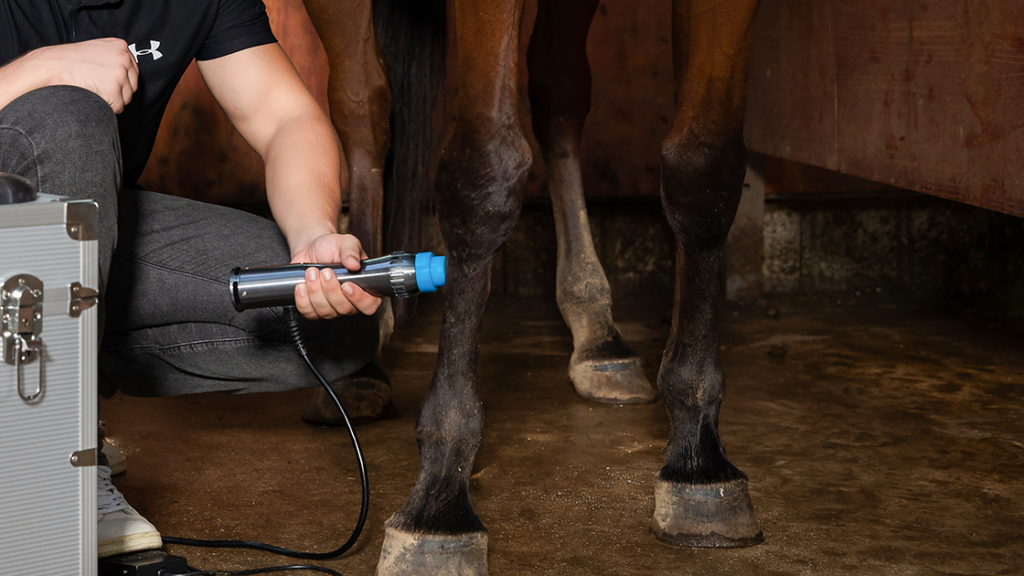Introduction to Shockwave Therapy for Horses
What is Shockwave Therapy?
Shockwave therapy, also known as extracorporeal shock wave therapy (ESWT), is a non-invasive treatment that uses high-energy sound waves to promote healing in injured tissues. Initially developed for human medicine, it has become a cornerstone in veterinary care, especially for treating musculoskeletal issues in horses. The therapy works by delivering controlled pulses of energy to the affected area, stimulating cellular responses that accelerate recovery processes.
The sound waves target the injured tissue by creating microtrauma, which, in turn, stimulates increased circulation, collagen production, and cell regeneration. It is particularly effective for tendon injuries, which are common in horses due to the stresses of training, racing, and competition.
Why Use Shockwave for Equine Tendon Injuries?
Tendon injuries are one of the most frequent and debilitating issues faced by horses, particularly in performance and racehorses. These injuries can cause pain, reduced mobility, and a lengthy recovery process, often requiring months of rest and rehabilitation. Traditional treatments such as anti-inflammatory medications, rest, and sometimes surgery, can be time-consuming and may not always lead to optimal recovery.
Shockwave therapy offers an alternative to these traditional methods, providing quicker healing, reduced pain, and the ability to get horses back to their competitive best. Not only does shockwave therapy promote faster recovery and improve tendon healing, but it also helps reduce the risk of recurrent injuries, making it a highly sought-after treatment for both acute and chronic tendon issues.
How Shockwave Therapy Treats Equine Tendon Injuries

Types of Tendon Injuries in Horses
There are several types of tendon injuries that can affect horses, each requiring specific treatment strategies:
- Superficial Flexor Tendon Injuries: These injuries occur in the tendon closest to the skin. They are common in racehorses and can lead to inflammation and swelling.
- Deep Flexor Tendon Injuries: Affecting the deeper tendons, these injuries are more severe and harder to treat. They often result from repetitive stress and can lead to long-term issues if not managed properly.
- Suspensory Ligament Injuries: These injuries involve the ligament that supports the horse’s lower leg, and they often occur during intense physical activity. They can be challenging to heal without the proper care.
- Acute and Chronic Tendon Injuries: Acute injuries occur suddenly and are often caused by trauma, while chronic tendon injuries develop over time due to repeated stress or inadequate healing.
How Shockwave Promotes Healing
Stimulates Blood Flow & Collagen Production
Shockwave therapy promotes healing by increasing blood circulation to the injured tendon, which is vital for tissue regeneration. Enhanced blood flow delivers oxygen, nutrients, and growth factors to the injured area, speeding up the repair process. Shockwave therapy also stimulates the production of collagen, a key protein in tendon repair, resulting in stronger and more flexible tendons.
Reduces Inflammation & Pain
One of the major benefits of shockwave therapy is its ability to reduce inflammation and pain. The shockwaves trigger a biological response that helps clear away the inflammatory mediators in the affected area. This results in less swelling, reduced pain, and the restoration of normal function more quickly. The therapy also helps desensitize nerve endings, providing pain relief without the need for medication.
Scientific Evidence & Case Studies
Scientific studies and real-world case studies support the effectiveness of shockwave therapy in treating tendon injuries in horses. Research has shown that shockwave therapy can accelerate healing by stimulating biological responses such as collagen synthesis, blood flow, and cellular regeneration. Numerous veterinary studies have demonstrated that horses receiving shockwave therapy recover faster from tendon injuries and experience fewer long-term complications compared to those treated with traditional methods.
For instance, a study conducted on horses with superficial flexor tendon injuries showed that horses treated with shockwave therapy healed 30% faster than those treated with rest and medications. Additionally, shockwave therapy has been shown to reduce the risk of reinjury, providing long-term benefits for horses with chronic tendon problems.
Buyer’s Perspective: Key Considerations

Is Shockwave Therapy Safe for Horses?
Safety Protocols and Guidelines
Shockwave therapy is a safe and FDA-approved treatment for horses when performed by a trained professional. The procedure is non-invasive and does not require anesthesia, making it suitable for horses of all ages and health conditions. However, certain safety protocols should be followed, including determining the appropriate intensity of the shockwaves based on the injury’s severity and the horse’s overall health.
Veterinary Recommendations
Veterinarians often recommend shockwave therapy for horses with soft tissue injuries, especially tendon and ligament injuries. They evaluate the injury’s severity, the horse’s recovery needs, and the effectiveness of previous treatments before recommending shockwave therapy.
Return on Investment (ROI) Analysis
The cost-effectiveness of shockwave therapy is a key consideration for many horse owners. While a single session may cost anywhere from $150 to $300, the therapy provides value through faster recovery, which reduces the risk of ongoing treatments and rehabilitation costs. Additionally, horses treated with shockwave therapy can return to competition or work sooner, which is crucial for performance horses. In the long term, shockwave therapy can reduce the need for expensive surgeries or long-term medication, offering a good ROI for competitive horse owners.
How to Choose the Right Provider
When selecting a provider for shockwave therapy, it’s important to choose a qualified veterinary professional who specializes in equine care. Ask about their experience with shockwave therapy, the type of equipment they use, and their approach to treatment. A reputable provider will ensure that the shockwave therapy is administered safely and effectively, with proper follow-up care.
Advanced Applications of Shockwave Therapy for Tendon Healing
Combining Shockwave Therapy with Other Treatment Modalities
Synergy with Platelet-Rich Plasma (PRP)
When combined with Platelet-Rich Plasma (PRP) therapy, shockwave therapy accelerates the healing of tendon injuries. PRP involves using the horse’s own blood, concentrating the platelets, and injecting them into the injury site to stimulate healing. Shockwave therapy enhances the effectiveness of PRP by improving blood circulation and collagen production, leading to faster recovery and better outcomes.
Combining Shockwave Therapy with Stem Cell Therapy
Stem cell therapy uses the horse’s stem cells to regenerate damaged tissue. When combined with shockwave therapy, it offers synergistic benefits. The shockwaves stimulate the stem cells to grow and regenerate tendon tissues more effectively, promoting long-term healing and functionality.
Preventative Use of Shockwave Therapy
Preventative Maintenance for Performance Horses
Performance horses are prone to tendon injuries due to constant physical exertion. Shockwave therapy can be used as a preventative treatment to enhance tendon health and reduce the risk of injuries. Regular sessions help maintain tendon elasticity and strength, ensuring that horses remain in optimal condition for competition.
Shockwave Therapy for Older Horses
Older horses may experience tendon degeneration and stiffness, making them prone to injuries. Shockwave therapy can help maintain tendon health in aging horses by improving circulation and collagen production, thereby enhancing mobility and reducing the risk of future injuries.
Enhanced Recovery for Competitive Horses
Faster Return to Training and Competition
Shockwave therapy helps horses recover more quickly, enabling them to return to training and competition sooner. This is crucial for racehorses and performance horses, where downtime directly impacts earnings and performance.
Improved Performance Post-Treatment
Horses treated with shockwave therapy show improved performance after recovering from tendon injuries. The therapy not only heals the injury but also strengthens tendons, improving flexibility and reducing the risk of future injuries.
Longevity in Competitive Sports
Reducing Risk of Recurrent Tendon Injuries
Shockwave therapy strengthens tendons, reducing the likelihood of recurrent injuries. By enhancing the healing process and preventing further damage, shockwave therapy extends the horse’s competitive career.
Shockwave Therapy for Long-Term Tendon Health
Using shockwave therapy regularly can help maintain long-term tendon health, ensuring that horses can continue performing at a high level throughout their careers. It improves tissue quality, reduces wear and tear, and enhances recovery after each competition.
Success Stories and Scientific Evidence
Case Studies from Elite Horse Owners and Trainers
High-Profile Success Stories
Success stories from trainers and elite horse owners highlight the effectiveness of shockwave therapy in healing tendon injuries and optimizing recovery. Horses that have undergone shockwave therapy have returned to high-level performance, showing faster recovery times and improved strength.
Recovery Timelines and Performance Improvements
Research and case studies show that horses treated with shockwave therapy typically experience a recovery time reduction of 30-50%. This not only reduces downtime but also allows horses to resume training and competition with enhanced physical capabilities.
Veterinarian Insights on Shockwave Therapy
Veterinary Expert Opinions
Veterinarians agree that shockwave therapy is an effective treatment for tendon injuries in horses. Experts recommend it for acute injuries and chronic conditions as it accelerates healing and reduces pain, enabling horses to regain full function.
Long-Term Benefits According to Experts
Veterinarians emphasize the long-term benefits of shockwave therapy for tendon health, including reducing the recurrence of injuries, improving tissue elasticity, and increasing performance longevity in competitive horses.
Final Takeaways
Shockwave therapy offers a promising, non-invasive solution for treating tendon injuries in horses. Its ability to stimulate healing, reduce pain, and improve recovery times makes it an invaluable tool for horse owners, trainers, and veterinarians. Whether for preventative care or rehabilitation, shockwave therapy is a powerful option for ensuring the longevity and performance of horses across various disciplines.
References
Equine shock wave therapy – where are we now?
https://beva.onlinelibrary.wiley.com/doi/full/10.1111/evj.13890
Review of the application and efficacy of extracorporeal shockwave therapy in equine tendon and ligament injuries:
https://beva.onlinelibrary.wiley.com/doi/abs/10.1111/eve.12780
